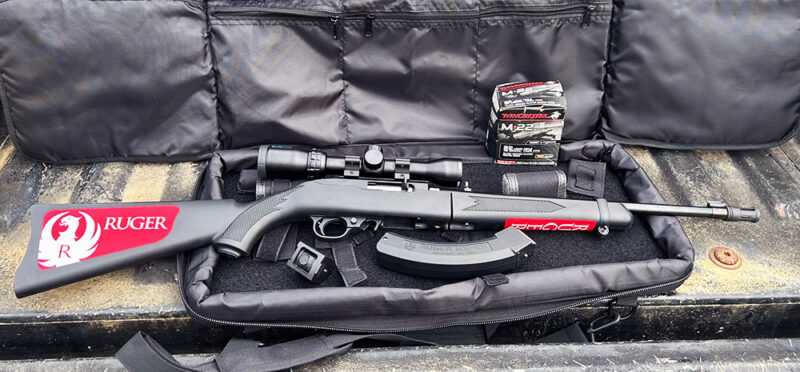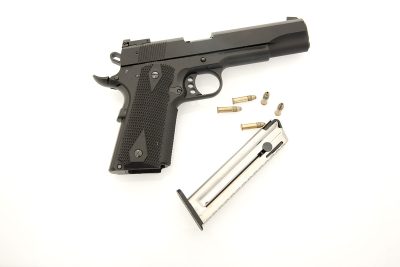By Paul Rackley, GunBroker.com Editor

Few firearms have resonated with shooters like the Ruger 10/22. For six decades, this handy little rifle has taken small game, plinked aluminum cans and thrilled young and old shooters alike. And while Ruger has made a few changes to the 10/22, it is mostly the same rifle introduced in 1964. That is until 2012 when the company brought out the Ruger 10/22 Takedown.
Based on the same basic design, the main distinctive feature of this portable rifle is in the name; this gun can be broken down into two pieces for easy storage and carry. Pretty much everything else is the same. The 10/22 Takedown features the same tried-and-true action, detachable rotary magazine and cross-bolt safety. All this continues the rifle’s long-time reliability and accuracy. It just makes it easier to store.
Takedown Features
The problem with a takedown rifle, however, is ensuring its accuracy over years of breakdown and reassembly. This is especially important regarding the zero on a scope. For the 10/22 Takedown, Ruger designed a new lockup system to ensure accuracy every time the rifle is taken apart and put back together.
“The adjustment ring holds the headspace, which maintains the rifle’s accuracy,” said Graham Rockwell, Ruger product manager.
The locking system is extremely solid. However, the true genius of the adjustment knob is that it can be continually tightened to adjust for wear in the system. Of course, this means that shooters have to follow instructions on adjusting the knob the first time they put it together. They then have to check it occasionally to ensure the headspacing is correct, making adjustments accordingly.
Assembling the 10/22 Takedown is actually quite simple. After loosening the adjustment knob, you insert the barrel assembly at a 45-degree angle and rotate it until it locks in place. The final step is turning the adjustment knob until it is finger tight and ready. Ruger, however, also recommends racking the bolt several times after every assembly to ensure placement.
Breakdown is conducted by pushing a small lever under the forend and twisting the barrel assembly and pulling it away from the receiver. The entire rifle can then be placed into the included bag and stored until needed.

Straight to Work
The Ruger 10/22 Takedown is a 10/22 that can break into two pieces. Everything else is the same. It comes with a gold bead front sight, adjustable rear sight and hammer-forged barrel. It even uses the ultra-reliable Ruger rotary magazine. Some models even come with a threaded barrel and flash suppressor, as did the test rifle.
The 10/22 is well known to be one heck of a rimfire rifle. As such, this review deals specifically with the accuracy regarding the assembly and disassembly of the 10/22 Takedown. The standard 10/22 is more than enough accurate enough for both hunting and shooting. In fact, with just a few tweaks, it can be a tack-driver. But can this rifle be pulled apart and put back together repeatedly and remain accurate and reliable?
For this, I attached a Bushnell Banner 1.5-4.5×32 scope. After sighting it at 25 yards, I tested accuracy at 25 and 50 yards. The accuracy was well within acceptable limits, with five-shot groups averaging a about half inch at 25 and inch at 50 yards. Ten-shot groups were larger but not by that much, minus a few fliers that were probably my fault.
I couldn’t, in fact, really tell any major difference between the Takedown and the 10/22 Carbine that I’ve owned for years. Both rifles were accurate and reliable; I only had two rounds that didn’t fire on the first trigger pull. The magazines were interchangeable between the models, as well as a 25-round aftermarket magazine.
The Breakdown Test
Since Ruger designed the 10/22 Takedown to be put together when needed, I developed two tests to determine the rifle’s after-assembly accuracy. The first followed Ruger’s recommendation of dry cycling the action after putting it together.
Basically, I assembled the rifle and cycled the action before each five-shot group, for a total of 25 rounds. I did the same between the 10-round groups as well, sending 50 rounds into the target.
The accuracy was on par with earlier tests. There were a few five-shot groups that opened a little, with the largest measuring 1.3 inches at 25 yards and 1.7 inches at 50; the smallest measured .6 inches and .8 inches, respectively. I did notice a small amount of zero shift, but it was less than a half inch in any direction. On most groupings, in fact, the zero stayed true.
For the second test, I didn’t cycle the action. My thought on this were that there might be times when a person needed to assemble the rifle without making lots of noise. This could be to take down a predator sneaking up on the chickens. Or possibly some sort of a survival situation. It doesn’t really matter why. For whatever reason, you can’t cycle the action. I wanted to know if the rifle would still be accurate if I took it apart and put it back together between every group and didn’t cycle the action.
According to my results, the answer is yes, for the most part. The groups opened up a little at both 25 and 50 yards. And as expected, 10-round groups at 50 yards measured the largest. I had a few more fliers than expected, but didn’t have any groupings that just blew up. Overall, the groups seemed pretty good. In fact, one five-shot group at 25 yards measured under a half inch. I did, however, obtain a little more zero shift. It wasn’t that the groups were any worse, the groups just shifted more often. However, the zero never shifted more than three-quarters of an inch. Could this result in a miss? Maybe, but it would have to be a fairly small target.
The Final Results of the Ruger 10/22 Takedown
According to my results, the Ruger 10/22 Takedown performs just as well as the standard 10/22 rifle. Sure, the groups were a little bit larger when assembling it without cycling the action and the zero shifted some. However, the groups weren’t outside of acceptable accuracy. In fact, as far as I could tell, the rifle was well within my capabilities.
There are other takedown .22 LR rifles, some of which are smaller and lighter. None, though, allow the level of customization of the 10/22 Takedown. Numerous manufacturers build custom parts for the 10/22, including the Takedown. Magpul produces two stocks for this rifle. This includes the X-22 Backpacker that contains an interesting method of attaching the front assembly to the rear for easy transport.
The simple fact is that the Ruger 10/22 Takedown is as good rimfire rifle as the original. It is just easier to store and transport. The included bag contains straps for securing each part of the rifle, pockets for storing magazines, ammo and other accessories, along with a shoulder strap for walking to the range. My only complaint is that is does not come with swivel studs for a sling. This didn’t stop me, however, from attaching this gun to my bug-out bag. I’m now just waiting for the suppressor to work its way through the ATF system.
Ruger 10/22 Takedown Specs
- Action: Semi-Auto
- Caliber: .22 LR
- Stock: Black Synthetic
- Barrel: Alloy Steel,Satin, Threaded with Flash Suppressor
- Twist: 1:16 RH
- Barrel Length: 16.4 inches
- Overall Length: 36.75 inches
- Weight: 4.6 lbs.
- MSRP: $579
- UPC: 7-36676-11112-1https://www.gunbroker.com/c/article/the-latest-rifles-for-2024/
Related Article: Features of Ruger PC Carbine 9mm
Related Article: The Latest Rifles of 2024







![Testing the Ruger 10/22 Rimfire on the Farm [Video]](https://content.gunbroker.com/wp-content/uploads/2022/10/An-Introduction-to-Rugers-Infamous-10-22-Video-400x250.jpg)
![How Well Do You Know the Ruger 10/22 Rifle? [Video]](https://content.gunbroker.com/wp-content/uploads/2020/11/gXp2DJwC-1280-400x225.jpg)
![Ruger Security-380 Lite Rack Compact Centerfire Pistol [Video]](https://content.gunbroker.com/wp-content/uploads/2023/02/ruger-Security_380-compact-pistol-400x250.jpg)
![Custom Ruger Precision Rifle RPR 6.5 Creedmoor [Video]](https://content.gunbroker.com/wp-content/uploads/2023/02/New-Custom-Ruger-Precision-Rifle-RPR-6.5-Creedmoor-Video-T0dXRKrB-1280-400x225.jpg)
